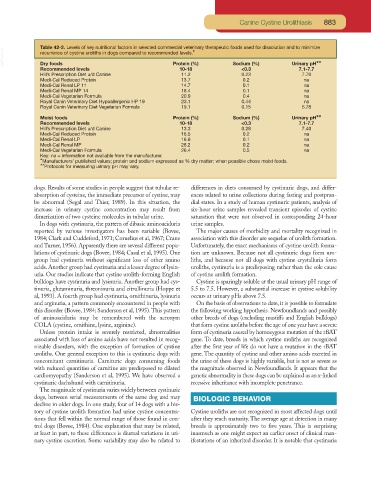Page 852 - Small Animal Clinical Nutrition 5th Edition
P. 852
Canine Cystine Urolithiasis 883
Table 42-2. Levels of key nutritional factors in selected commercial veterinary therapeutic foods used for dissolution and to minimize
VetBooks.ir recurrence of cystine uroliths in dogs compared to recommended levels.* Sodium (%) Urinary pH**
Dry foods
Protein (%)
Recommended levels 10-18 <0.3 7.1-7.7
Hill’s Prescription Diet u/d Canine 11.2 0.23 7.70
Medi-Cal Reduced Protein 13.7 0.2 na
Medi-Cal Renal LP 11 14.7 0.1 na
Medi-Cal Renal MP 14 18.4 0.1 na
Medi-Cal Vegetarian Formula 20.9 0.4 na
Royal Canin Veterinary Diet Hypoallergenic HP 19 23.1 0.44 na
Royal Canin Veterinary Diet Vegetarian Formula 19.1 0.15 6.78
Moist foods Protein (%) Sodium (%) Urinary pH**
Recommended levels 10-18 <0.3 7.1-7.7
Hill’s Prescription Diet u/d Canine 13.3 0.28 7.40
Medi-Cal Reduced Protein 16.5 0.2 na
Medi-Cal Renal LP 16.8 0.1 na
Medi-Cal Renal MP 28.2 0.2 na
Medi-Cal Vegetarian Formula 26.4 0.5 na
Key: na = information not available from the manufacturer.
*Manufacturers’ published values; protein and sodium expressed as % dry matter; when possible chose moist foods.
**Protocols for measuring urinary pH may vary.
dogs. Results of some studies in people suggest that tubular re- differences in diets consumed by cystinuric dogs, and differ-
absorption of cysteine, the immediate precursor of cystine, may ences related to urine collections during fasting and postpran-
be abnormal (Segal and Thier, 1989). In this situation, the dial states. In a study of human cystinuric patients, analysis of
increase in urinary cystine concentration may result from six-hour urine samples revealed transient episodes of cystine
dimerization of two cysteine molecules in tubular urine. saturation that were not observed in corresponding 24-hour
In dogs with cystinuria, the pattern of dibasic aminoaciduria urine samples.
reported by various investigators has been variable (Bovee, The major causes of morbidity and mortality recognized in
1984; Clark and Cuddeford, 1971; Cornelius et al, 1967; Crane association with this disorder are sequelae of urolith formation.
and Turner, 1956). Apparently there are several different popu- Unfortunately, the exact mechanisms of cystine urolith forma-
lations of cystinuric dogs (Bovee, 1984; Casal et al, 1995). One tion are unknown. Because not all cystinuric dogs form uro-
group had cystinuria without significant loss of other amino liths, and because not all dogs with cystine crystalluria form
acids. Another group had cystinuria and a lesser degree of lysin- uroliths, cystinuria is a predisposing rather than the sole cause
uria. Our studies indicate that cystine urolith-forming English of cystine urolith formation.
bulldogs have cystinuria and lysinuria. Another group had cys- Cystine is sparingly soluble at the usual urinary pH range of
tinuria, glutaminuria, threoninuria and citrullinuria (Hoppe et 5.5 to 7.5. However, a substantial increase in cystine solubility
al, 1993). A fourth group had cystinuria, ornithinuria, lysinuria occurs at urinary pHs above 7.5.
and arginuria, a pattern commonly encountered in people with On the basis of observations to date, it is possible to formulate
this disorder (Bovee, 1984; Sanderson et al, 1995).This pattern the following working hypothesis. Newfoundlands and possibly
of aminoaciduria may be remembered with the acronym other breeds of dogs (excluding mastiffs and English bulldogs)
COLA (cystine, ornithine, lysine, arginine). that form cystine uroliths before the age of one year have a severe
Unless protein intake is severely restricted, abnormalities form of cystinuria caused by homozygous mutation of the rBAT
associated with loss of amino acids have not resulted in recog- gene. To date, breeds in which cystine uroliths are recognized
nizable disorders, with the exception of formation of cystine after the first year of life do not have a mutation in the rBAT
uroliths. One general exception to this is cystinuric dogs with gene. The quantity of cystine and other amino acids excreted in
concomitant carnitinuria. Carnituric dogs consuming foods the urine of these dogs is highly variable, but is not as severe as
with reduced quantities of carnitine are predisposed to dilated the magnitude observed in Newfoundlands. It appears that the
cardiomyopathy (Sanderson et al, 1995). We have observed a genetic abnormality in these dogs can be explained as an x-linked
cystinuric dachshund with carnitinuria. recessive inheritance with incomplete penetrance.
The magnitude of cystinuria varies widely between cystinuric
dogs, between serial measurements of the same dog and may BIOLOGIC BEHAVIOR
decline in older dogs. In one study, four of 14 dogs with a his-
tory of cystine urolith formation had urine cystine concentra- Cystine uroliths are not recognized in most affected dogs until
tions that fell within the normal range of those found in con- after they reach maturity.The average age at detection in many
trol dogs (Bovee, 1984). One explanation that may be related, breeds is approximately two to five years. This is surprising
at least in part, to these differences is diurnal variations in uri- inasmuch as one might expect an earlier onset of clinical man-
nary cystine excretion. Some variability may also be related to ifestations of an inherited disorder. It is notable that cystinuria

